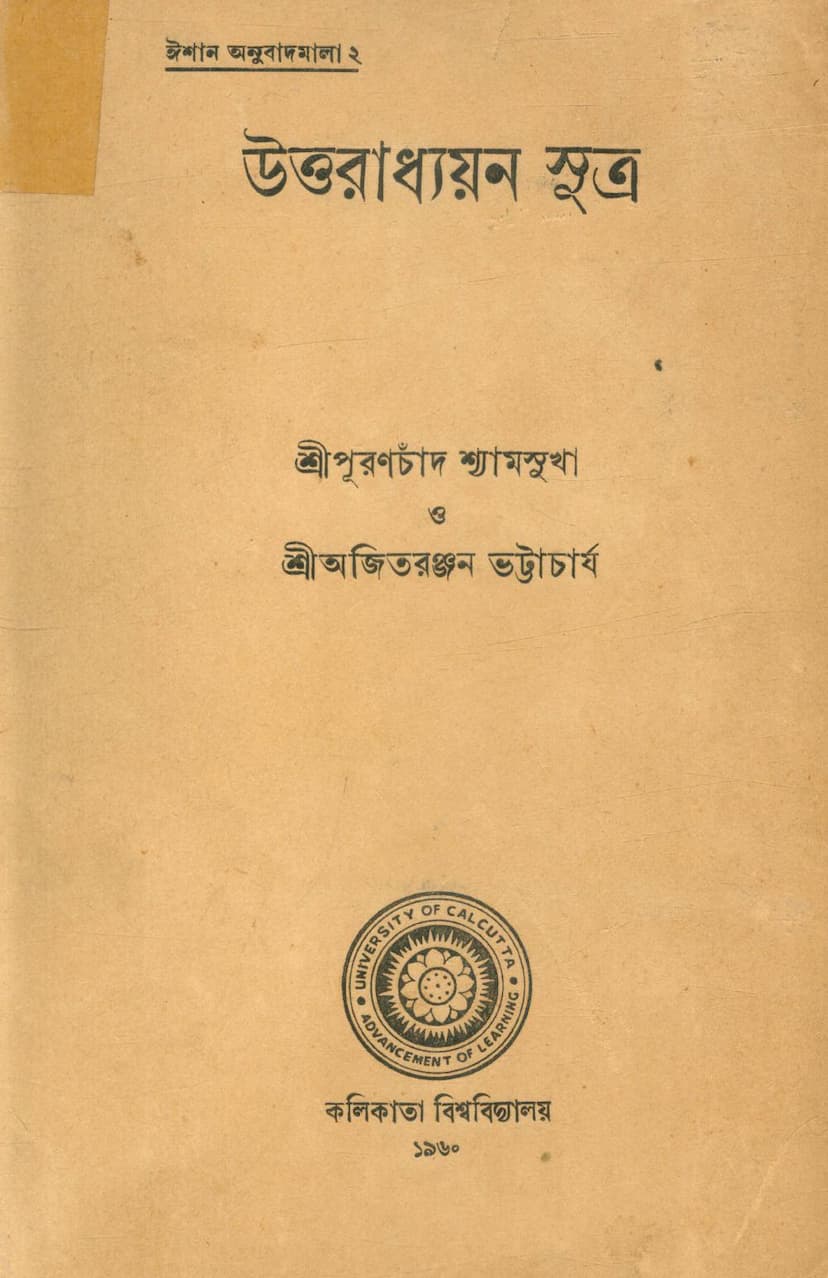Uttaradhyayan Sutra Part 01 Bengali
Added to library: September 2, 2025

Summary
This Bengali text, "Uttaradhyayan Sutra Part 01," published by the University of Calcutta in 1960, is a comprehensive Bengali translation and edition of the Jain text, the Uttaradhyayan Sutra. The work was translated and edited by Sri Puranachand Shyamasukha, a professor at the University of Calcutta, and Ajitranjan Bhattacharya.
The text is presented with the original text in Bengali script, word meanings, a Bengali translation, textual variations, footnotes, a glossary, an index of footnotes, and an introduction. It is noted as the second book of the Ishan Chandra Ghosh Fund.
The introduction provides a significant overview of Jain Agamashastra, the collection of Jain scriptures. It explains the origin of the Agamas, their division into Angas and other scriptures, and the role of Ganadharas (chief disciples of Tirthankaras) in their compilation. The introduction traces the history of the compilation and recitation of the Jain Agamas, mentioning key events like the Pataliputra council, the Mathura recitation, the Valabhi recitation, and the final compilation under Acharya Devardhigani Kshamashramana.
The text lists the currently accepted forty-five Agamashastras, categorizing them into Angas (eleven), Upangas (twelve), Chedasutras (six), Mulasutras (four), Churikasutras (two), Prakirnakas (ten), and Painnas (twenty). It also mentions the larger collection of eighty-four Agamashastras.
The Uttaradhyayan Sutra itself is identified as part of the Mulasutras. The introduction notes that the text contains thirty-six chapters (Adhyayanas) of varying lengths and subjects. It also delves into the possible etymologies of the name "Uttaradhyayan," suggesting it might refer to its position as a later study after the Acara Anga or its connection to the thirty-six answers to questions given by Lord Mahavir. The introduction highlights the ancient nature of the language and style of the Uttaradhyayan Sutra and its value in understanding the thought processes of ancient Jain ascetics.
The text then proceeds to present the translated chapters of the Uttaradhyayan Sutra. The provided snippet includes:
- Chapter 1: Vinayashruta Adhyayan (On Discipline/Humility): This chapter discusses the importance of humility, obedience to the guru, understanding the guru's gestures, and the qualities of a disciplined disciple. It contrasts a disciplined disciple with an undisciplined one, using analogies of animals to illustrate the negative consequences of indiscipline.
- Chapter 2: Parishaha Adhyayan (On Endurances/Hardships): This chapter details the twenty-two types of hardships (parishahas) that ascetics must endure, as explained by Lord Mahavir. It lists them and begins to explain the first few, such as hunger, thirst, cold, heat, and the hardships caused by insects and lack of clothing.
- Chapter 3: Chaturangiya (The Four Limbs): This chapter discusses the four rare and valuable attainments for a living being: human birth, the teachings of the Tirthankaras, the right faith, and the strength to practice asceticism. It elaborates on the cycle of birth, death, and rebirth, and how the karmic cycle leads beings to different states of existence.
- Chapter 4: Asanskruta (The Unprepared/Unpreparedness): This chapter emphasizes the impermanence of life and the inevitability of old age and death. It warns against carelessness and the futility of relying on worldly possessions for protection. It stresses the importance of self-reliance and spiritual practice.
- Chapter 5: Akamamaraṇīya (Unintentional Death): This chapter distinguishes between intentional (kamamaaraṇa) and unintentional (akamamaaraṇa) death, with a focus on the latter, highlighting the suffering that arises from attachment to worldly pleasures and the consequences of an undisciplined life leading to painful rebirths.
- Chapter 6: Kshullaka Nighranthiya (The Minor Ascetic): This chapter appears to discuss the conduct and discipline of a minor ascetic, emphasizing detachment from worldly possessions and attachments.
- Chapter 7: Kapilīya (On Kapil Muni): This chapter recounts the story of Kapil Muni, a sage who attained liberation. It likely highlights his spiritual journey, renunciation, and the teachings he imparted.
- Chapter 8: Drumapatraka (The Falling Leaf): This chapter uses the analogy of a falling leaf to illustrate the impermanence of life and the inevitability of death, urging the reader to practice dharma without delay.
- Chapter 9: Namipravrajya (Nami's Renunciation): This chapter narrates the story of King Nami's renunciation of his kingdom and worldly pleasures to embrace asceticism. It highlights his spiritual insights and the challenges he faced, including temptations from Indra.
- Chapter 10: Ishukariya (On Ishukara): This chapter seems to narrate the story of a sage named Ishukara and his teachings, possibly focusing on detachment and spiritual discipline.
- Chapter 11: Savikshu (On the Ascetic): This chapter focuses on the conduct and virtues of an ascetic, detailing the right path and the qualities necessary for spiritual progress.
- Chapter 12: Keshi Gautamiya (On Keshi and Gautama): This chapter likely features a dialogue or discourse between the sage Keshi and the disciple Gautama, discussing philosophical concepts and the path to liberation.
The excerpt also includes a "Shuddhipatra" (Correction Sheet) at the end, indicating that the initial printing had some errors that were later corrected. The provided catalog link directs to a digital copy of this specific Bengali edition.